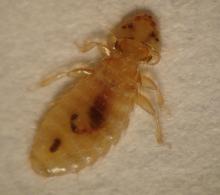Includes
Chicken body louse (Menacanthus stramineus)
Shaft louse (Menapon gallinae)
Chicken mite (Dermanyssus gallinae)
Northern fowl mite (Ornithonyssus sylviaum)
Scaly leg mite (Menapon gallinae) - May cause leg deformities if not treated.
Management-chemical control
For direct application to chicken, duck, goose, and turkey. Treatment for scaly leg mite requires dipping the dipping the limbs into mixtures of oils and dish soap to suffocate the mite.
- permethrin 0.25% dust (Prozap Insectrin Dust) at 1 lb per 100 birds. Thoroughly treat vent area.
- permethrin spray (Revenge Barn & Stable Fly Spray) at 8 oz /16.5 gal water. Spray at the rate of 0.5 oz per bird, or 1 gal per 100 birds, with a fine mist. Spray roosts, walls and nests or cages.
- tetrachlorvinphos 23% Dichlorvos 5.3% (Ravap EC)-1 gal/50 gal water. Apply 1 gal dilution per 100 birds using high pressure to vent areas. Use 1 oz spray per bird. Use 1 to 2 gal/1,000 sq ft of litter. Treat walls, roosts, cracks, and crevices. Retreatment interval 14 days.
- tetrachlorvinphos 50% (Rabon 50WP) at 0.5% solution. Apply directly to birds using 1 gal spray mixture per 100 birds. Retreatment interval 14 days.
For application to litter and housing
- tetrachlorvinphos (Ravap EC) roost paint-1 gal/25 gal water; use 1 gal spray per 100 sq ft of roost area. Apply as brush-on or spray. Use 1 to 2 gal/1,000 sq ft of litter. Treat walls, roosts, cracks, and crevices. Retreatment interval 14 days.
- tetrachlorvinphos (Rabon 50W) spray-50% WP at 4 lb/25 gal water. Paint brush or hand spray 1 pint/100 ft of roost. Stir occasionally and apply thoroughly. May also be dusted; refer to label.
For more information
Common Lice and Mites of Poultry: Identification and Treatment (https://anrcatalog.ucanr.edu/pdf/8162.pdf)
Pest Management Recommendations for Poultry. https://extension.psu.edu/pest-management-recommendations-for-poultry


